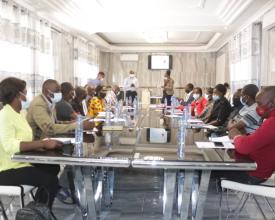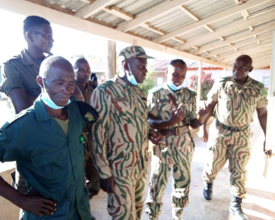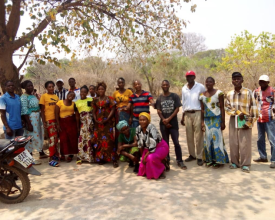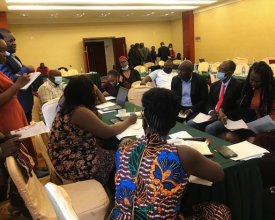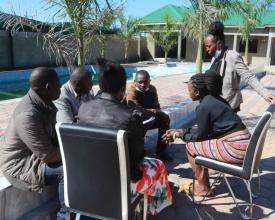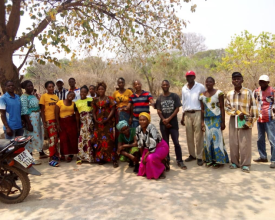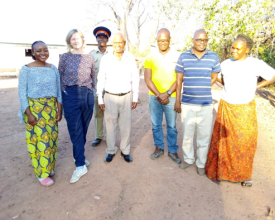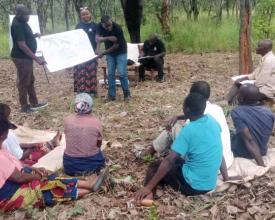Améliorer la gouvernance et la conservation dans la gestion des zones protégées par la biodiversité.
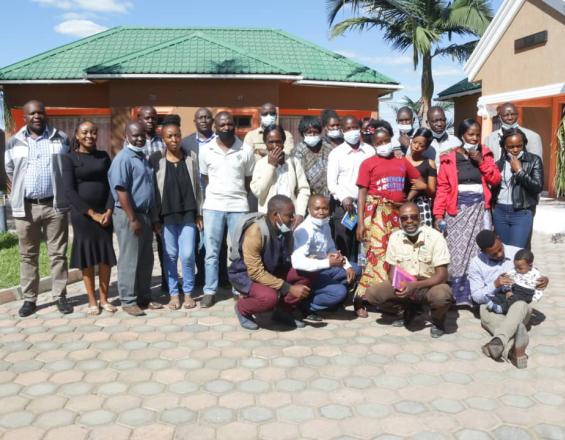
La gouvernance est considérée comme l'un des principaux défis en matière de conservation communautaire et de gestion de la biodiversité dans les zones protégées en Zambie. Un projet visant à améliorer la gouvernance de la GCRN pour un meilleur résultat de conservation et un meilleur résultat social en abordant les priorités pour améliorer la gestion et la gouvernance a été lancé. Une évaluation au niveau du site pour la gouvernance et l'équité (SAGE) et l'évaluation de la gouvernance pour les zones protégées (GAPA) ont été utilisées pour identifier les lacunes en matière de gouvernance et développer des actions grâce à la participation des parties prenantes. Ce projet a été mis en œuvre dans 6 GMA dans les paysages de Kafue et du Lower Zambezi. Les activités ont été menées dans 12 CRB et 67 VAG et plus de 60 % des femmes et des jeunes ont participé au programme de renforcement des capacités.
Contexte
Défis à relever
Parmi les principaux défis à relever figurent les questions de gouvernance (telles que le manque de sensibilisation, l'application inéquitable de la loi, les conflits entre l'homme et la faune, le manque de coordination entre les parties prenantes et les menaces qui pèsent sur la conservation de la biodiversité en raison de l'utilisation non durable des ressources et des faibles bénéfices qu'en retirent les communautés locales).
Les défis ont été relevés en développant la capacité des organisations communautaires à améliorer la gouvernance et à contribuer à la gestion de la biodiversité dans les zones protégées. Il utilise les outils SAGE et GAPA pour évaluer la performance de la gouvernance au niveau du site et l'équité au niveau de la zone protégée. Sur la base de l'étude de base et du plan d'action, des activités ont été identifiées et le projet a facilité le soutien pour traiter certaines questions de gouvernance telles que l'encouragement du dialogue sur l'empiètement, l'application de la loi, le partage de l'information et la coordination des parties prenantes.
Emplacement
Traiter
Résumé du processus
Le développement du profil du site et l'analyse des lacunes en matière de gouvernance constituent une base de référence pour aider à comprendre les problèmes au niveau du site, puis conduisent à l'engagement et à la collaboration des parties prenantes, ce qui devient essentiel pour avoir une vision et des tâches communes, y compris pour rassembler les ressources. Ce processus aide ensuite à formuler des actions collectives, à communiquer les résultats du projet et à apporter un soutien continu par le biais du mentorat, de la toux et de la formation. Cela conduit à des mécanismes d'apprentissage, d'adoption et d'adaptation aux problèmes et aux interactions, et à la manière de surmonter les défis de gouvernance et d'obtenir des résultats sociaux et de conservation dans la gestion des zones protégées, et ce par le biais d'un échange entre pairs.
Blocs de construction
Profil du site et analyse des lacunes en matière de gouvernance
Un bref profil du site (base de référence) a été élaboré pour aider à comprendre les lacunes et les problèmes de gouvernance dans les zones protégées ciblées. Ce processus a également permis d'identifier les principaux acteurs concernés par la mise en œuvre du projet au niveau du site.
Facteurs favorables
L'adhésion de la communauté et l'engagement du gouvernement et des autres parties prenantes ont rendu le processus plus participatif. L'utilisation de l'outil SAGE a encouragé une plus grande interaction et a contribué à la mise en œuvre du projet. Le personnel technique et les équipes sur le terrain ont également été toujours disponibles pour guider le processus.
Leçon apprise
L'enquête de base visant à établir le profil du site et l'analyse des lacunes en matière de gouvernance a nécessité la coopération et la collaboration d'autres parties prenantes, en particulier les chefs traditionnels et le gouvernement. Il s'agit également d'un processus lent qui nécessite une planification et une préparation adéquates.
Engagement et collaboration des parties prenantes
L'amélioration de la gouvernance et de la conservation dans la gestion des zones protégées de la biodiversité nécessite une participation et une collaboration solides de la part de tous les acteurs des zones protégées. Ce processus a également impliqué l'analyse des parties prenantes et de leur contribution à la gouvernance du site. La planification d'une vision commune et la mise en place d'un mécanisme de coordination continue.
Facteurs favorables
Une bonne participation des parties prenantes et le soutien du gouvernement et des chefs traditionnels. La nature participative de l'outil permet une planification et une évaluation plus larges de l'action collective.
Leçon apprise
La participation des parties prenantes a permis de rassembler les ressources et de convenir d'une action commune, ce qui a grandement facilité la mise en œuvre. La participation des parties prenantes a permis de rassembler les ressources et de convenir d'une action commune, ce qui a facilité la mise en œuvre. En règle générale, il convient de se concentrer sur les questions de gouvernance pertinentes, telles que l'égalité entre les hommes et les femmes, la participation et le partage des informations. Le processus est devenu coûteux, en particulier pour la mise en œuvre d'autres activités, en raison du grand nombre de parties prenantes.
Plan d'action, communication et soutien.
Cette étape a permis d'élaborer des actions pour relever les défis en matière de gouvernance, de communiquer des informations, de former et d'assurer un mentorat et un accompagnement continus des conseils des ressources communautaires dans la mise en œuvre des actions de gouvernance. L'enjeu principal de cette étape était de créer des opportunités pour avoir une vision commune et des actions collectives.
Facteurs favorables
Une bonne participation des parties prenantes et le soutien du gouvernement et des chefs traditionnels. La nature participative de l'outil permet une planification et une évaluation plus larges de l'action collective.
Leçon apprise
Elle nécessite une planification adéquate et l'identification des principales questions de gouvernance à analyser et à traiter. En général, vous voudrez vous concentrer sur des questions de gouvernance pertinentes telles que l'égalité des sexes, la participation et le partage de l'information.
Adoption et adaptation
Ce processus a impliqué un apprentissage de pair à pair entre les différents sites des bénéficiaires du projet, afin d'apprendre les uns des autres, d'adopter certaines pratiques de bonne gouvernance et de s'adapter à leurs situations locales, comme la manière de structurer de bons mécanismes de partage des bénéfices.
Facteurs favorables
Les communautés bénéficiaires partageaient des défis de gouvernance similaires, et parfois le même paysage, et étaient familiarisées avec des problèmes communs. Le partage des leçons tirées sur les différents sites, la mise en œuvre conjointe et l'interaction entre pairs ont joué un rôle important dans le partage des réussites et des défis.
Leçon apprise
Les défis en matière de gouvernance sont les mêmes dans tous les sites de Zambie et nécessitent la mise en place de politiques et de législations nationales pour soutenir une conservation efficace menée par les communautés. Les approches de gestion des ressources naturelles basées sur la communauté sont cruciales pour une gestion réussie des zones protégées.
Impacts
L'intervention, grâce à une subvention du BIOPAMA, a eu un impact positif, notamment une amélioration générale du partage de l'information et la formation de 670 membres du comité VAG en matière de leadership et d'organisation communautaire. 60 éclaireurs communautaires et agents de la police de la faune ont été formés à une application plus équitable et plus efficace de la loi. Des réunions de dialogue avec les communautés et les parties prenantes sur les conflits homme-faune et l'application de la loi ont été organisées à Chiawa et à Mufunta avec une participation globale de 90 personnes, dont 40 % de femmes. Afin d'améliorer le partage des informations, un total de 1000 brochures ont été produites et distribuées dans les communautés. En outre, 600 exemplaires des rôles et responsabilités et des résultats du projet ont été distribués. Le projet a contribué à améliorer la communication et la coordination entre les parties prenantes dans la zone du projet. Les activités du projet ont également été présentées lors de la plus grande conférence nationale sur la GCRN, qui s'est tenue en décembre 2022 en Zambie. Un groupe national d'apprentissage de la GCRN a également été mis en place pour conseiller sur les pratiques de GCRN, et le personnel du projet a partagé ses expériences lors du Congrès africain des zones protégées à Kigali. Plus d'informations sur la réussite du projet ont été produites et diffusées par le biais de blogs.
Bénéficiaires
- Communautés de 12 CRB (Kabulwebulwe, Mulendema, Chibuluma, Mufunta, Kaingu, Chilyabufu, Shimbidzi, Chiawa, Mphanshya, Mphuka, Mburuma, Shikabeta).
- Chefs traditionnels.
- Personnel du gouvernement.
Objectifs de développement durable
Histoire
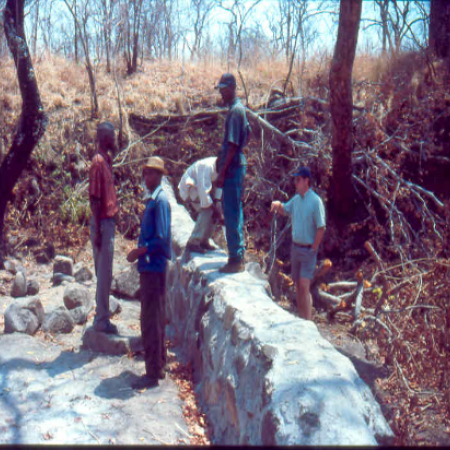
J'ai assisté à une réunion un matin de juin 1996, où le Dr Brian Child, expert en conservation communautaire, a tenu une réunion dans une école locale où j'enseignais et a présenté le concept de gestion communautaire des ressources naturelles et la façon dont cette approche peut renforcer les communautés locales qui vivent côte à côte avec la nature, la faune et l'environnement. Ce programme devait permettre de conserver les revenus issus de l'utilisation durable des ressources naturelles provenant de la chasse au trophée dans ma région. Il est intéressant de noter que j'ai été inspiré et que j'ai participé à cette formation de trois jours et qu'en fin de compte, les communautés locales ont reçu leurs dividendes des fonds générés par la chasse au safari. C'était la première fois que cela se produisait à l'époque.
Cela m'a incité à changer de carrière et à devenir un champion local de la conservation communautaire qui profite aux populations locales. Je me suis rapidement fixé pour objectif de travailler pour la communauté. En l'espace de quelques mois, j'ai été élu membre d'un des groupes d'action villageois locaux, puis secrétaire de ma chefferie, le comité de développement de la région de Msoro. Nous avons lancé un programme communautaire de scouts pour protéger la faune et la flore et nous avons également construit des barrages pour fournir de l'eau à la faune et à la flore. Beaucoup plus de jeunes de mon âge se sont portés volontaires pour devenir scouts, et à partir des 12 scouts employés dans ma région, le programme s'est développé pour couvrir l'ensemble de la zone géographique de Lupande, et plus de 60 scouts ont été employés.
Plus tard, j'ai été coopté dans le projet et je suis devenu le chef du programme de conservation communautaire. Grâce aux échanges que j'ai eus au fil des ans, je suis devenu un défenseur des droits des communautés à bénéficier de la conservation. Actuellement, ce programme a bénéficié à de nombreuses personnes dans le pays et davantage de jeunes et de femmes ont été formés pour devenir de bons défenseurs de l'environnement. Après des débuts très modestes, je suis devenue une icône régionale et je préside actuellement le réseau des dirigeants communautaires d'Afrique australe, qui défend les intérêts des communautés locales.


